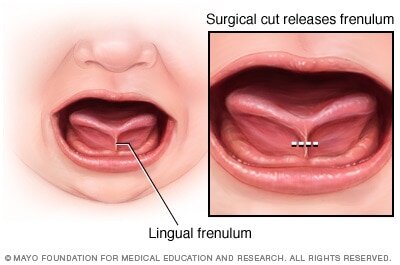
Tongue-Tie
What is Tongue-Tie?
A tongue-tie is a condition where the tongue is being restricted by a thin band of tissue - called a lingual frenum - to the floor of the mouth creating limited tongue mobility. Everyone has a lingual frenum but sometimes it is tighter or shorter then it should be. Tongue-ties are always present at birth and often go unnoticed, having negative impacts on oral development, oral function, speech, breathing, and more.
When your tongue is in the right place it helps with craniofacial development. A tongue-tie affects tongue posture, causing it to rest low in the mouth. A low resting tongue is an orofacial myofunctional disorder and if not treated can lead to other health concerns such as mouth breathing, headaches, clenching and grinding, and even sleep apnea. Orofacial Myofunctional Therapy can help!
Symptoms of Tongue Tie:
In Infants - Difficulty breastfeeding or bottle feeding, colic, reflux, painful nursing, poor weight gain, difficulty introducing solids, open mouth posture and ear infections
In Children - Gagging or choking on foods, messy or noisy eating, delayed speech development, ear infections, teeth grinding, snoring, poor dental health, narrow pallet, orthodontic needs, and mouth breathing.
In Adults - Chronic headaches or migraines, neck and shoulder tension, jaw pain, teeth grinding/clenching, snoring/sleep apnea, orthodontic needs or relapse, mumbled speech, poor dental health, digestive issues and mouth breathing.
How Can OMT Help?
When someone has been identified as having a tongue-tie, myofunctional exercises may not be enough to retrain the tongue to a proper resting position. They may require a simple surgical procedure called a “frenectomy” to release the restricted frenum to allow proper tongue resting position.
At MyoBalance, at the initial assessment everyone is screened for a tongue-tie and we can help determine if a frenectomy may be required. Not everyone with a tongue-tie needs a frenectomy, but if you/your child are not able to establish the 4 goals of OMT, then you/your child will be referred to a qualified provider to perform the procedure.
Pre/Post Frenectomy Care:
Orofacial Myofunctional Therapy(OMT) helps ensure that your tongue-tie release surgery is successful. When there is a tongue-tie, the muscles of the tongue have not been properly used, so even after a tongue-tie is released there is a risk of reattachment. It is essential to complete a series of exercises and stretches before and after the procedure to retrain the tongue and prevent the frenum from healing back into its original place.
For best results, OMT should begin at lease 6 weeks before your procedure is scheduled.
What is a Frenectomy?
A frenotomy is a simple incision into the connective tissue under the tongue to free the tongue from the floor of the mouth. The procedure is low risk, and can be performed with a laser, scalpel, or scissors. When done with laser - no sutures are needed, when done with scalpel or scissors - sutures are placed to help the wound heal. Wound healing usually takes 1-2 weeks, although it may take longer depending on the situation and if pre/post frenectomy care was involved.



